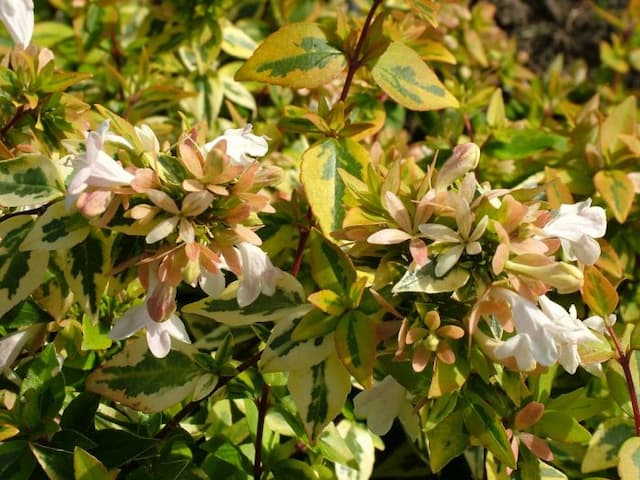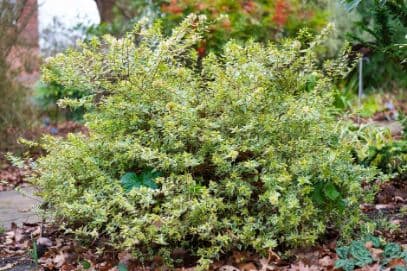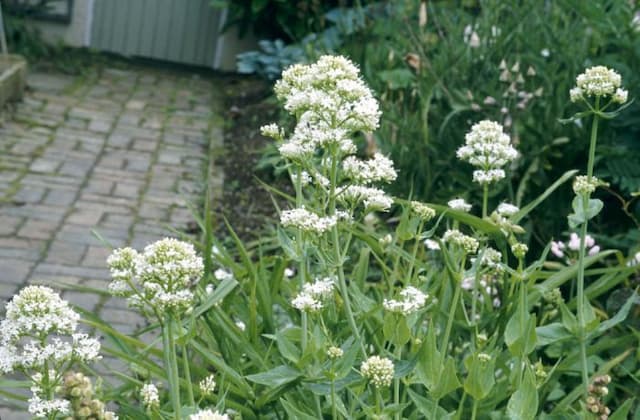Glossy Abelia Abelia × grandiflora

ABOUT
Abelia × grandiflora, commonly known as glossy abelia, is a graceful shrub that is widely admired for its decorative appearance. This plant exhibits a semi-evergreen nature, often retaining its leaves throughout much of the year, depending on the climate. The glossy abelia has a rounded shape with arching branches that give it a flowing, slightly weeping look. Its leaves are ovate to lance-shaped and have a shiny, leathery texture which lends to its common name. They are typically small, glossy, and have a rich green color that may transition to a bronze hue in the fall, although leaf color can vary with cultivar and environmental conditions. One of the most charming features of the glossy abelia is its flowers. The plant blooms profusely over a long period, often from late spring to early fall. The flowers are small and tubular, with a delicate, bell-shaped appearance. They are typically white or pale pink and have a light, sweet fragrance. The clusters of flowers emerge from the leaf axils and at the tips of the branches, attracting butterflies, bees, and other pollinators to the garden. The overall appearance of the glossy abelia is of a dense, bushy plant that adds texture and interest to the landscape. Its fine stems and small, dense leaves create an intricate pattern, and the abundant flowers give it a soft, romantic presence. The glossy abelia is versatile in garden design and can serve as an effective backdrop for other plants or as a feature in its own right. Its ability to bloom over an extended season adds lasting beauty and appeal to gardens where it is planted.
About this plant
 Names
NamesFamily
Caprifoliaceae
Synonyms
Glossy Abelia, Large-flowered Abelia
Common names
Zabelia × grandiflora, Linnaea × grandiflora.
 Toxicity
ToxicityTo humans
Glossy Abelia is not known to be toxic to humans. There are no common reports of poisoning or adverse health effects from ingestion or contact with this plant. Therefore, it's generally considered safe in a landscape where humans, including children, might interact with it.
To pets
Glossy Abelia is also not known to be toxic to pets. It is generally considered non-poisonous for dogs, cats, and horses. There are no well-documented cases of pet poisoning from ingesting parts of this plant, and it is not listed as toxic by the American Society for the Prevention of Cruelty to Animals (ASPCA).
 Characteristics
CharacteristicsLife cycle
Perennials
Foliage type
Semi-deciduous
Color of leaves
Green
Flower color
White
Height
3-6 feet (0.9-1.8 meters)
Spread
3-6 feet (0.9-1.8 meters)
Plant type
Shrub
Hardiness zones
6
Native area
China
Benefits
 General Benefits
General Benefits- Ornamental Appeal: Abelia × grandiflora, commonly known as glossy abelia, features attractive glossy leaves and bell-shaped flowers that add aesthetic value to landscapes.
- Long Blooming Season: Glossy abelia has a lengthy blooming period, often from late spring to fall, providing extended visual interest.
- Attracts Wildlife: The flowers of the glossy abelia are a source of nectar for pollinators such as bees and butterflies, enhancing biodiversity.
- Drought Tolerance: Once established, glossy abelia is relatively drought-tolerant, making it suitable for xeriscaping and water-wise gardens.
- Low Maintenance: It requires minimal care beyond occasional pruning, making it an easy choice for gardeners of all levels.
- Versatility: Glossy abelia can be used in various garden settings, including borders, hedges, and foundation plantings.
- Seasonal Interest: In addition to its summer flowers, some glossy abelia varieties offer fall foliage color, adding to their year-round appeal.
- Deer Resistance: This plant is generally resistant to deer, preventing it from being heavily browsed in areas with deer populations.
 Medical Properties
Medical PropertiesThis plant is not used for medical purposes.
 Air-purifying Qualities
Air-purifying QualitiesThis plant is not specifically known for air purifying qualities.
 Other Uses
Other Uses- Abelia × grandiflora, commonly known as Glossy Abelia, can be used in floral arrangements due to its long-lasting and attractive foliage and flowers.
- The stems of Glossy Abelia may be utilized in basket weaving as they are flexible and can be shaped when young.
- In photography and film sets, Glossy Abelia's dense foliage serves as a natural backdrop or to simulate undergrowth environments.
- For educational purposes, Glossy Abelia can be used to teach plant propagation techniques like stem cuttings due to its high success rate of rooting.
- Due to its dense growth habit, Glossy Abelia can be used as a natural sound barrier in gardens located near busy streets.
- Glossy Abelia can serve as a living support for climbing plants that require a structure to grow on, acting symbiotically in a garden setting.
- Bonsai enthusiasts may use Glossy Abelia for creating miniature tree landscapes because of its small leaves and the ease of pruning to shape.
- The glossy leaves of the Abelia can be used in crafts, such as creating natural wreaths or other decorative foliage displays.
- In urban environments, Glossy Abelia may be planted as part of green roofing projects due to its tolerance of pruning and its relatively shallow root system.
- Gardeners use Glossy Abelia as a barometer for soil pH; the flower color can indicate the soil pH, turning more purple in acidic conditions.
Interesting Facts
 Feng Shui
Feng ShuiGlossy Abelia is not used in Feng Shui practice.
 Zodiac Sign Compitability
Zodiac Sign CompitabilityGlossy Abelia is not used in astrology practice.
 Plant Symbolism
Plant Symbolism- Adaptability: Abelia × grandiflora, commonly known as Glossy Abelia, is known for its ability to adapt to different environments, symbolizing the capacity to adjust and thrive in various conditions.
- Grace: With its arching branches and delicate flowers, Glossy Abelia represents elegance and poise, much like the graceful manner in which it grows.
- Attraction: The flowers of Glossy Abelia are known to attract butterflies and bees, symbolizing allure and the ability to draw others in.
- Rejuvenation: As this plant can bloom from late spring until the first frost, it is often associated with renewal and the continuous cycle of life and rebirth.
- Long-lasting: The Glossy Abelia's ability to provide long-lasting foliage and flowers symbolizes endurance and the long-term fruition of efforts or relationships.
 Water
WaterGlossy Abelia should be watered deeply once every week during its first growing season to help establish a strong root system. After establishment, water it every two weeks unless there is significant rainfall, as Glossy Abelia is drought-tolerant. The amount of water typically needed is approximately 1-2 gallons per plant for each watering session, depending on soil type and climate. During hot and dry periods, increase watering frequency, but always allow the soil to dry out slightly between watering to prevent root rot.
 Light
LightGlossy Abelia prefers full sun to partial shade for optimal growth. The perfect spot would be an area that receives at least 6 hours of direct sunlight, but it can also tolerate and thrive with some light shade during the day. Avoid deeply shaded areas as this can affect the plant's blooming and overall vibrancy.
 Temperature
TemperatureGlossy Abelia is hardy in a range of temperatures, with the ideal growing conditions occurring between 60°F and 85°F. It can typically survive minimum temperatures down to about 5°F and maximum temperatures well over 95°F. To ensure vigorous growth and flowering, try to maintain the temperature within the ideal range as much as possible.
 Pruning
PruningPruning Glossy Abelia promotes healthy growth, maintains its shape, and encourages more prolific flowering. It should be pruned in late winter or early spring before new growth starts, removing any dead or weak wood and shaping the plant as desired. It can be pruned annually, but because it blooms on new wood, ensure not to over-prune as this could reduce the blooms in the following season.
 Cleaning
CleaningAs needed
 Soil
SoilGlossy Abelia thrives best in well-drained soil with a high content of organic matter and an acidic to slightly alkaline pH between 5.5 and 7.5. A good mix might be equal parts of garden soil, peat moss, and perlite or coarse sand to ensure proper drainage and aeration.
 Repotting
RepottingGlossy Abelia is usually grown as an outdoor shrub and does not typically require repotting. In landscapes, ensure it is planted at a site where it can grow without transplanting since it prefers to remain undisturbed.
 Humidity & Misting
Humidity & MistingGlossy Abelia is adaptable to a range of humidity levels but prefers moderate conditions. It does well in the average humidity found in outdoor garden settings without the need for special attention to humidity levels.
 Suitable locations
Suitable locationsIndoor
Provide bright light, well-draining soil, and moderate water.
Outdoor
Plant in sun to part-shade, well-drained soil, moderate watering.
Hardiness zone
6-9 USDA
 Life cycle
Life cycleAbelia × grandiflora, commonly known as Glossy Abelia, begins its life cycle when seeds germinate in spring, given warm temperatures and moist soil conditions. Seedlings emerge and develop into young plants with bright, glossy leaves and a bushy habit. As the plant matures, it enters a vegetative stage marked by vigorous stem and leaf growth, preparing for the blooming phase. Flowering typically occurs during the late spring to fall, where it produces fragrant, tubular flowers that attract pollinators, essential for the reproductive process. Following pollination, the flowers develop into small, inconspicuous seed-bearing capsules, although propagation is most commonly achieved through cuttings rather than seeds. Glossy Abelia exhibits a perennial life span, where it can survive through winters in a semi-dormant state and resume active growth with the return of warmer seasons.
 Propogation
PropogationPropogation time
Spring-Early Summer
The most popular method of propagation for Abelia × grandiflora, commonly known as Glossy Abelia, is by semi-hardwood cuttings. This typically occurs in late summer. To propagate by semi-hardwood cuttings, one would cut a stem that is beginning to firm up but still has some flexibility, usually around 4 to 6 inches (10 to 15 centimeters) in length. The leaves on the lower half of the cutting should be removed, and the cut end dipped in rooting hormone to encourage root development. Afterward, the cutting should be planted in a well-draining soil mixture and kept moist but not saturated. A plastic covering can help to maintain humidity around the cutting, which aids in rooting. With consistent warmth and moisture, the cuttings usually root within several weeks.









